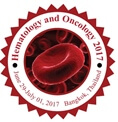Ayishah Choudhary
University of health sciences, Pakistan
Title: Comparison of Plasminogen Activator Inhibitor (PAI-1), factor VII and fibrinogen levels in obese and non-obese children
Biography
Biography: Ayishah Choudhary
Abstract
Background: Childhood obesity is often related to cardiovascular diseases and accompanied by a dysregulation of coagulation and fibrinolytic systems. Obesity have been found to be associated with increased levels of Factor VII, Fibrinogen, Plasminogen activator inhibitor (PAI-1) and PAI-1 gene (-675bp 4G/5G) polymorphism. Therefore, we investigated the hemostatic parameters i.e. factor VII, fibrinogen, plasminogen activator inhibitor and PAI-1 4G/5G gene polymorphism in childhood obesity.
Methods: In this cross-sectional study, 42 obese (mean age, 8.91±2.56) and 42 healthy weight (mean age, 9.27±2.29) children, classified by Body Mass Index (BMI) were recruited. They were assessed for anthropometric measures. Factor VII levels were determined by chromogenic assay, fibrinogen levels were determined by clotting method of Clauss and PAI-1 levels in plasma were determined by Colorimetric Assay. PAI-1 4G/5G polymorphism was analyzed by polymerase chain reaction-restriction fragment length polymorphism.
Results: BMI, waist and hip circumference (p<0.001) were significantly higher in obese children. Plasma factor VII level, fibrinogen were significantly higher in obese group as compared to other group (p<0.001). Plasma PAI-1 in obese (mean 32±16) is higher than non-obese (mean 26±16) but statistically not significant. The allele frequency of 4G (obese 0.66% and non-obese 0.34%, odds ratio 0.385, p value-<0.001) was significantly higher. The genotype frequency of 4G/4G in obese 15% and in non-obese 2%, 4G/5G in obese was 5% and non-obese is 37% and 5G/5G in obese was 5% and non-obese is 37%.
Conclusion: The results suggest that obesity may play role in regulation of hemostatic factors. Even in childhood, obesity is associated with unfavorable concentration of hemostatic factors that are in turn implicated in cardiovascular morbidity and mortality later in life.

